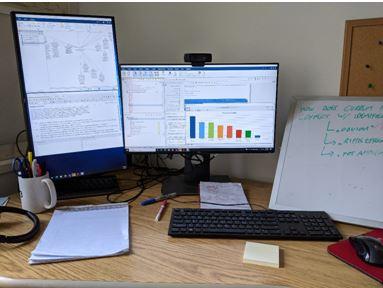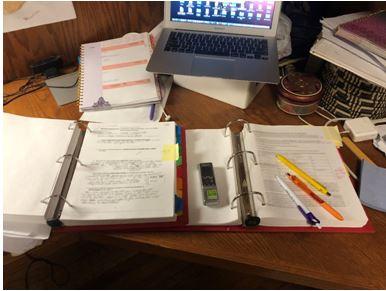Doing Qualitative Research
Collaborate
![]() Collaborate – Think Critically: Learn from researchers who have been in your shoes – use their examples and experiences to explore how their ‘lessons learned’ can improve your own research approach. Take it one step further with additional thought-provoking questions online.
Collaborate – Think Critically: Learn from researchers who have been in your shoes – use their examples and experiences to explore how their ‘lessons learned’ can improve your own research approach. Take it one step further with additional thought-provoking questions online.
15.1: Explore the analysis spaces of other researchers
Get started
● Take a close look at the images below – they are snapshots of the analysis workspaces of experienced researchers.
● Additionally, you could reach out to experienced analysts (e.g., a lecturer, a student who is currently analyzing their data, or your academic advisor). Ask them to send you a picture of their analysis space for this exercise. The picture can also be a great conversation prompt when you talk to more experienced analysts about their work.
Image 1 (Photographer: Christina Silver)

Image 2 (Photographer: Christian Schmieder)

Image 3 (Photographer: Nancy Kendall)

Guiding questions:
- Observe: What objects do you see? Name as many as you can (if you do this with a partner, you can make a competition out of it). Which of these objects do you see on your desk or analysis space?
- Speculate: Based upon the objects you see, how do you think these analysts interact with their data? What questions would you ask them about their workflow?
- Reflect: What objects, what ‘things’ do you currently use when you think or write? How do you combine them to shape and assist your thinking/writing?
- Reflect: Based upon what you know about QDAS so far – where could the software ‘fit in’ in this ecology of objects-for-thinking?
Take this exercise further – what does a nurturing analysis space look like for you?
Beyond the objects we need for analysis: Being in a safe and comfortable environment is important for thinking and writing.
- Go to the Reddit subgroup “r/CosyPlaces” (https://www.reddit.com/r/CozyPlaces/). Scroll through 25–50 pictures that show desks and interior rooms. Which of these spaces would you like to do analysis in? What are the features of these spaces that would contribute to your well-being as a person, and as a writer and thinker? This is a great exercise you can do with a partner.
- Reflect: How does a happy analysis/writing/thinking space look for you? What can you introduce or change to improve or maintain your well-being? Do you have access to such a space?
- Reach out: If you do not have access to a nurturing space, contact your libraries – they might have reserved spaces that you could use or can give you pointers regarding where to find them. Also, contact your advisor – there may be spaces that they know of that can help you do your analysis in a safe and nurturing environment.
15.2: Find a local QDAS community and observe how they work
Together with a classmate, friend or colleague, investigate where other QDAS users are located in your University. Start out with asking mentors, advisors and more senior students if they use QDAS, or if they know people who do. Contact your library to see if they know of any user groups or workshops related to QDAS. Peruse your University’s course catalogue and search for classes on qualitative methods; then contact the instructors of these classes and ask them if they can point you towards any current users of QDAS.
After this, contact local QDAS users to ask if you can join (AO1) and observe them as they use QDAS. This could be done online or offline, but you’ll most likely get a better sense of how analysis plays out in time and space if you have a chance to observe in person. Be prepared to take notes – this is also a great practice to sharpen your observation skills! Visit this book’s online material for more detailed instructions and prompts for analyzing what’s going on in the analysis session you’ll observe.
Get started:
● Together with a classmate, friend or colleague, investigate where other QDAS users are located in your University. Start out with asking mentors, advisors and more senior students if they use QDAS, or if they know people who do. Contact your library to see if they know of any user groups or workshops related to QDAS. Peruse your University’s course catalogue and search for classes on qualitative methods; then contact the instructors of these classes and ask them if they can point you towards any current users of QDAS.
● After this, contact local QDAS users to ask if you can join and observe them as they use QDAS. This could be done online or offline, but you’ll most likely get a better sense of how analysis plays out in time and space if you have a chance to observe in person. If you do this exercise with a partner, you could observe different users and later meet to compare notes and discuss.
● Be prepared to take notes – this is a practice to sharpen your observation skills!
Prompts for observing an analysis session
- If you join in person: On a piece of paper, draw an outline of the room you are observing. Make a list of the (digital and non-digital) objects analysts use during the session. How do these objects facilitate the session? Did you observe any frustrations with the space and setup of the room that analysts displayed?
- What is the role of QDAS in the analysis session? What products made from QDAS are they using? How are they using QDAS during the session?
- To what extent are analysts communicating or exchanging information? Are they working together, or side-by-side?
- Name the tasks the group is trying to accomplish. Observe how the analysts are trying to get the tasks done. What are they doing, in very concrete terms?
- To support you in answering these questions, print out the list of QualPal technique cards (LINK).
- Observe what techniques they use to get the tasks done; on your printed QualPal list, mark each technique that you observe. Pay close attention to what these techniques accomplish, and take note of that on the QualPal card.
- If you do this exercise with a partner who is observing a different group, you can later compare your QualPal cards to see how different analysts used and assembled these techniques, and you can discuss the role of QDAS related to these techniques.
- Together, reflect on how you would use the techniques during analysis, and how you could use QDAS to support you with these techniques. You can find additional instructions in the QualPal materials.
- As you are observing the analysts, prepare one or two questions that you may have for the analysis group. They might ask you about your observations as well, so be prepared to highlight one or two things that you found interesting or inspiring.
- After the session, write up your notes, in full sentences. If you worked with a partner, share the notes with them and compare what you’ve learned from observing the sessions.
Online resource material for this chapter authored by Christian Schmieder.
